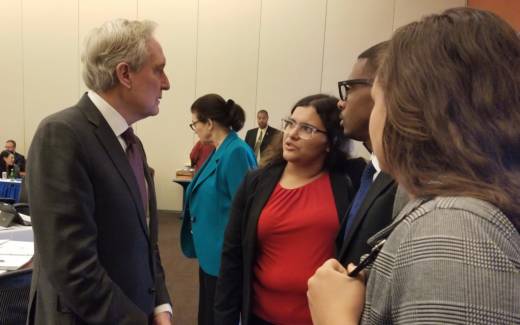At UC regents’ bimonthly meeting today, student association leaders gave a presentation on how they had mobilized dozens of students to testify at state budget hearings, flooded legislators with phone calls and leveraged social media with the hashtag #FundTheUC.
The strategy paid off. Gov. Jerry Brown signed a budget for the 2018-2019 year that boosts support for UC by nearly $350 million — though much of that is in one-time funds.
“I think your advocacy was extraordinary. I think the way you organize and the message you delivered is the reason why we’re sitting here today so much better than we were a year ago,” regent Sherry Lansing told students.
The love fest was a far cry from the often-adversarial relationship between student activists and regents in the past. One reason: UC has needed student voices to make a compelling case to legislators jaded by university financial scandals.
The partnership with students came about because of “some of the attitudes in the Legislature about the university and the sense that we needed to address those,” said Board of Regents chair George Kieffer. He said he is making a point to attend student association meetings so the discussion can continue.
“UC’s adapting because they’re realizing that what’s been done in the past wasn’t working,” said Siegel Singh.
Despite the new collaboration, regents’ meetings can still be a forbidding environment for some students. Police barricades surrounded the conference center on UCSF’s Mission Bay campus, where Wednesday’s meeting took place. Public comment began at the decidedly non-student-friendly hour of 8:30 a.m. and wrapped up in less than two hours.
UC Berkeley undergraduate Stephanie Luna, there to ask regents to divest from companies involved in the Trump administration’s immigration crackdown, said the $60 tuition reprieve wouldn’t affect her much.
“When the cost of attendance is about $30,000 a year — even more for out-of-state students — $60 is pocket change,” she said.
But the slight decrease after years of tuition hikes was a symbolic victory, said Max Lubin, a Berkeley graduate student and former Obama administration staffer who founded the student lobbying group Rise Inc. to fight for tuition-free college. The group has brought a sheen of professionalism to students’ grass-roots organizing, incorporating as a 501(c)4 and offering paid fellowships for students to do advocacy work.
“If we continue to do what we did this year,” Lubin said, “we can roll tuition back, and we can roll it back to zero.”
This story and other higher education coverage are supported by the College Futures Foundation.
CALmatters.org is a nonprofit, nonpartisan media venture explaining California’s policies and politics.

